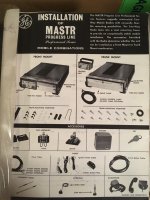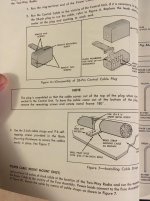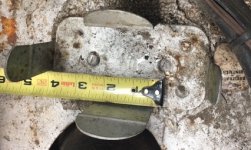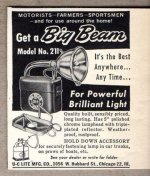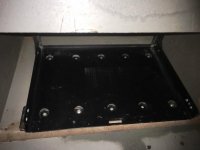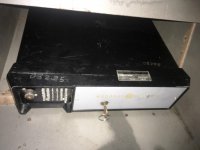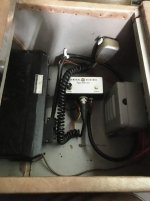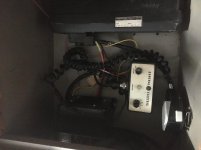Nicholas Studer
PCS Elected Director 2022-2025
The radio setup from my 1969 Stoner-Chevrolet "Crash Wagon" (http://www.professionalcarsociety.org/forums/showthread.php?t=21907) was apparently removed in 1993 when the plant shut down. The only remaining component of unknown installation is the black plastic GE fuse block holder mounted in the engine bay. It is for this reason, I suspect a GE product was installed at least at some point. The car is from late 1969, and was apparently transferred from Huntington Beach to Tulsa sometime in the 1970s. The radio could and probably has been changed out several times - making this harder. I don't want to install any 1980s+ equipment. I am aiming to get what fits (I am not going to drill any new holes) and is most likely correct to its early service in Tulsa.
I consider myself rather fascile with the radio options common to our vehicles from 1950-1980, but I'm rather stumped. I've consulted Kevin O'Connell as well, and we're both still a bit confused. Perhaps someone will see something we didn't. There are no records from AF Plant 3 apparently left, and while I reached out to the M-D Retiree's Association, Tulsa FD Museum, and various places on Facebook this has yet to bear too much fruit. Steve Lichtman tells me EMSA and TFD used separate GE and Motorola systems, and neither could talk to M-D Fire Dept. I sure wish Steve Loftin had photographed the interior when he photographed this car in service.
1. There are two antennas on the roof, both fairly standard Antenna Specialists VHF antennas with one at approx. 25", the other 18". Three antenna cables correspond and run down the headliner down the passenger B-pillar. A third antenna cable runs from "nowhere" down to the floor, I suspect this is a remnant of laziness during a likely re-install from Huntington beach to Tulsa. All cables have the length to run along the console to enter it.
2. There is no evidence of a radio being mounted behind the passenger seat on the divider or floor. I even got underneath with a flashlight to be sure.
3. The only spot where holes are present is in the console compartment. This makes best sense. There are multiple sets of holes. I've attached an overhead photo from the passenger seat showing the rear-ward compartment to left and forward portion (with switches, etc.) to the right. I believe the small set of holes on the driver's side wall are for a now-missing mic holder. They seem to have vacillated about this at various points during its service life, and there are five separate spots a mic holder appears to have been placed. Two remain present - one on the dash and this one on the side which currently holes the PA-15 mic. A Motorola "hang-up box" fits some empty holes drilled into the "POSITIVELY NO SMOKING" decal on the console (last photo) - but I've left it off for now pending radio ID.
4. The large compartment to the left is where I suspect the radio drawer would have gone. There are three holes approx. 13" fron the absolute rear of the compartment. They are four inches apart for a total of 8 inches across GE MASTR II as well as Motorola MOTRAC, MICOR, and MOCOM 70 radio drawers do not fit, let alone align with the holes. I do not have any other radio drawers in my possession to test. However, MASTR Professional/Royal Professional is 19" long and appears to be too long to install.
5. There are three clear sets of holes that I would suspect go to speaker, and/or control head (if they did not install a front/dash-mount model). Two sets are shown in the right side of the overhead photo that are two central holes of approx. 2.5" center-to-center with four indentations in the wood surrounding that represent tight, downward pressure over time. The set to the left is also 2.5", but does not have the surrounding indentation.
a. This does appear to match up with GE MASTR II/MASTR Executive II and Motorola MICOR speaker brackets, but these do not have anything that would create the indentations present. I do not have any Motorola MOTRAC/MOCOM 70 speaker brackets spare to test, but they are a flat metal base that wouldn't do that either even if they did fit.
b. GE MASTR II and Executive II control head brackets do not seem to match up to any of the three sets of holes. A MOTRAC/MOCOM 70 control head bracket does appears to match, however - this also wouldn't account for the four indentations seen on the front two sets.
6. There's three holes that appear to be on a diagonal on the passenger side. Perhaps this was used to hold down the cables? Even the laziest install probably wouldn't put things at an angle, but you never know.
It gets to be a lot of permutations of radio options when you look at all the "economy" products that were possibly used as well. M-D was a big company, and it's interesting two antennas were on the roof. There could even have been two radios at the same time. My best guess at this point is MASTR Executive, shown at http://www.repeater-builder.com/ge/lbi-library/lbi-4325b.pdf and http://www.wb6nvh.com/GE/GEhist2.htm as this unit is 12.25 to 12.50 inches long (depending on trunk/front mount) and dates 1965-1973. I have been unable to turn one up to at least test. Thoughts appreciated.
I consider myself rather fascile with the radio options common to our vehicles from 1950-1980, but I'm rather stumped. I've consulted Kevin O'Connell as well, and we're both still a bit confused. Perhaps someone will see something we didn't. There are no records from AF Plant 3 apparently left, and while I reached out to the M-D Retiree's Association, Tulsa FD Museum, and various places on Facebook this has yet to bear too much fruit. Steve Lichtman tells me EMSA and TFD used separate GE and Motorola systems, and neither could talk to M-D Fire Dept. I sure wish Steve Loftin had photographed the interior when he photographed this car in service.
1. There are two antennas on the roof, both fairly standard Antenna Specialists VHF antennas with one at approx. 25", the other 18". Three antenna cables correspond and run down the headliner down the passenger B-pillar. A third antenna cable runs from "nowhere" down to the floor, I suspect this is a remnant of laziness during a likely re-install from Huntington beach to Tulsa. All cables have the length to run along the console to enter it.
2. There is no evidence of a radio being mounted behind the passenger seat on the divider or floor. I even got underneath with a flashlight to be sure.
3. The only spot where holes are present is in the console compartment. This makes best sense. There are multiple sets of holes. I've attached an overhead photo from the passenger seat showing the rear-ward compartment to left and forward portion (with switches, etc.) to the right. I believe the small set of holes on the driver's side wall are for a now-missing mic holder. They seem to have vacillated about this at various points during its service life, and there are five separate spots a mic holder appears to have been placed. Two remain present - one on the dash and this one on the side which currently holes the PA-15 mic. A Motorola "hang-up box" fits some empty holes drilled into the "POSITIVELY NO SMOKING" decal on the console (last photo) - but I've left it off for now pending radio ID.
4. The large compartment to the left is where I suspect the radio drawer would have gone. There are three holes approx. 13" fron the absolute rear of the compartment. They are four inches apart for a total of 8 inches across GE MASTR II as well as Motorola MOTRAC, MICOR, and MOCOM 70 radio drawers do not fit, let alone align with the holes. I do not have any other radio drawers in my possession to test. However, MASTR Professional/Royal Professional is 19" long and appears to be too long to install.
5. There are three clear sets of holes that I would suspect go to speaker, and/or control head (if they did not install a front/dash-mount model). Two sets are shown in the right side of the overhead photo that are two central holes of approx. 2.5" center-to-center with four indentations in the wood surrounding that represent tight, downward pressure over time. The set to the left is also 2.5", but does not have the surrounding indentation.
a. This does appear to match up with GE MASTR II/MASTR Executive II and Motorola MICOR speaker brackets, but these do not have anything that would create the indentations present. I do not have any Motorola MOTRAC/MOCOM 70 speaker brackets spare to test, but they are a flat metal base that wouldn't do that either even if they did fit.
b. GE MASTR II and Executive II control head brackets do not seem to match up to any of the three sets of holes. A MOTRAC/MOCOM 70 control head bracket does appears to match, however - this also wouldn't account for the four indentations seen on the front two sets.
6. There's three holes that appear to be on a diagonal on the passenger side. Perhaps this was used to hold down the cables? Even the laziest install probably wouldn't put things at an angle, but you never know.
It gets to be a lot of permutations of radio options when you look at all the "economy" products that were possibly used as well. M-D was a big company, and it's interesting two antennas were on the roof. There could even have been two radios at the same time. My best guess at this point is MASTR Executive, shown at http://www.repeater-builder.com/ge/lbi-library/lbi-4325b.pdf and http://www.wb6nvh.com/GE/GEhist2.htm as this unit is 12.25 to 12.50 inches long (depending on trunk/front mount) and dates 1965-1973. I have been unable to turn one up to at least test. Thoughts appreciated.
Attachments
-
 2019-02-21 14.42.00.jpg184.5 KB · Views: 232
2019-02-21 14.42.00.jpg184.5 KB · Views: 232 -
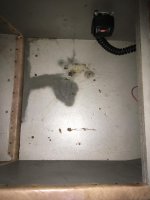 2019-02-21 14.34.06.jpg189.4 KB · Views: 225
2019-02-21 14.34.06.jpg189.4 KB · Views: 225 -
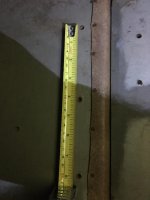 2019-02-21 14.32.35.jpg206.8 KB · Views: 227
2019-02-21 14.32.35.jpg206.8 KB · Views: 227 -
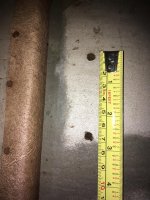 2019-02-21 14.32.52.jpg190 KB · Views: 226
2019-02-21 14.32.52.jpg190 KB · Views: 226 -
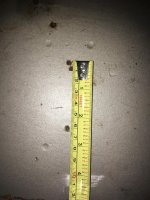 2019-02-21 14.33.39.jpg189.5 KB · Views: 229
2019-02-21 14.33.39.jpg189.5 KB · Views: 229 -
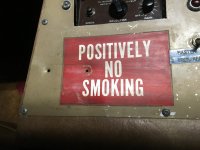 2018-11-24 00.06.20.jpg184 KB · Views: 226
2018-11-24 00.06.20.jpg184 KB · Views: 226 -
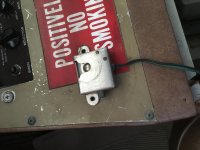 2019-01-05 16.23.00.jpg190.4 KB · Views: 227
2019-01-05 16.23.00.jpg190.4 KB · Views: 227
Last edited:


